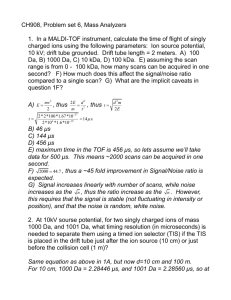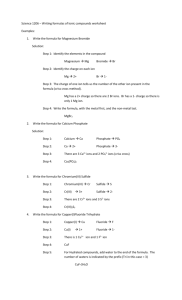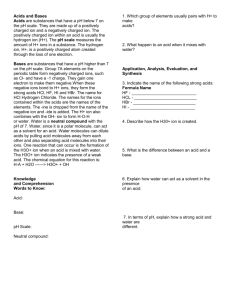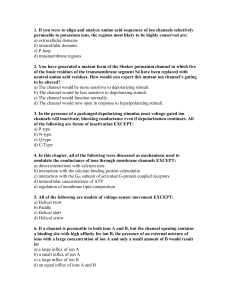Cloud Point Extraction Methodology for Separation and
advertisement
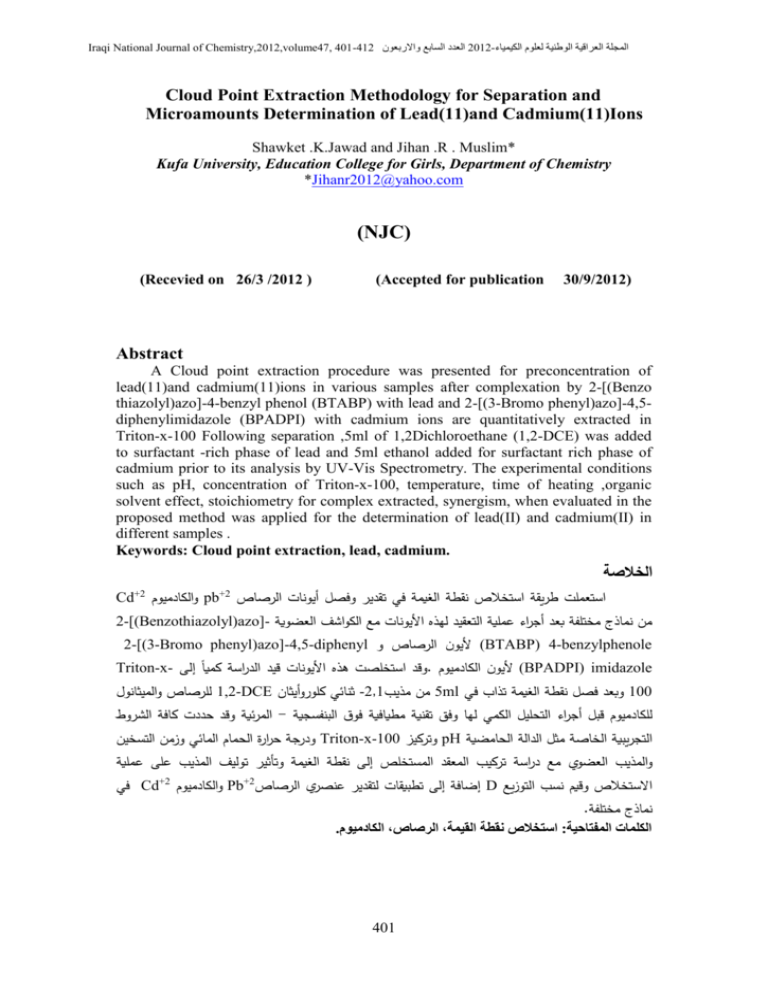
Iraqi National Journal of Chemistry,2012,volume47, 401-412 العدد السابع واالربعون2102-المجلة العراقية الوطنية لعلوم الكيمياء Cloud Point Extraction Methodology for Separation and Microamounts Determination of Lead(11)and Cadmium(11)Ions Shawket .K.Jawad and Jihan .R . Muslim* Kufa University, Education College for Girls, Department of Chemistry *Jihanr2012@yahoo.com (NJC) (Recevied on 62/3 /2012 ) (Accepted for publication 03/9/2012) Abstract A Cloud point extraction procedure was presented for preconcentration of lead(11)and cadmium(11)ions in various samples after complexation by 2-[(Benzo thiazolyl)azo]-4-benzyl phenol (BTABP) with lead and 2-[(3-Bromo phenyl)azo]-4,5diphenylimidazole (BPADPI) with cadmium ions are quantitatively extracted in Triton-x-100 Following separation ,5ml of 1,2Dichloroethane (1,2-DCE) was added to surfactant -rich phase of lead and 5ml ethanol added for surfactant rich phase of cadmium prior to its analysis by UV-Vis Spectrometry. The experimental conditions such as pH, concentration of Triton-x-100, temperature, time of heating ,organic solvent effect, stoichiometry for complex extracted, synergism, when evaluated in the proposed method was applied for the determination of lead(II) and cadmium(II) in different samples . Keywords: Cloud point extraction, lead, cadmium. الخالصة Cd+2 والكادميومpb+2 استعملت طريقة استخالص نقطة الغيمة في تقدير وفصل أيونات الرصاص 2-[(Benzothiazolyl)azo]- من نماذج مختلفة بعد أجراء عملية التعقيد لهذه األيونات مع الكواشف العضوية 2-[(3-Bromo phenyl)azo]-4,5-diphenyl ( أليون الرصاص وBTABP) 4-benzylphenole Triton-x- وقد استخلصت هذه األيونات قيد الدراسة كمياً إلى. ( أليون الكادميومBPADPI) imidazole للرصاص والميثانول1,2-DCE ثنائي كلوروأيثان-2,0 من مذيب5ml وبعد فصل نقطة الغيمة تذاب في100 المرئية وقد حددت كافة الشروط- للكادميوم قبل أجراء التحليل الكمي لها وفق تقنية مطيافية فوق البنفسجية ودرجة ح اررة الحمام المائي وزمن التسخينTriton-x-100 وتركيزpH التجريبية الخاصة مثل الدالة الحامضية والمذيب العضوي مع دراسة تركيب المعقد المستخلص إلى نقطة الغيمة وتأثير توليف المذيب على عملية فيCd+2 والكادميومPb+2 إضافة إلى تطبيقات لتقدير عنصري الرصاصD االستخالص وقيم نسب التوزيع .نماذج مختلفة . الكادميوم، الرصاص، استخالص نقطة القيمة:الكلمات المفتاحية 401 Iraqi National Journal of Chemistry,2012,volume47 العدد السابع واالربعون2102-المجلة العراقية الوطنية لعلوم الكيمياء benzyl phenol(BTABP) synthesized according to thesis[5], but the ligand 2[(3-Bromophenyl)azo]-4,5- diphenyl imidazole (BPADPI) as anew ligand synthesized according to general procedure [6]. The Calibration Curve for Pb+2 and Cd+2 ions was established using standard solutions prepared at optimum Conditions for each ion.Pb(NO3)2 in purity 99.99% from (B.H.D),Cd(NO3)2,in purity 99.99% from (Merk),Triton-X-100 purity Analer from (B.H.D),1,2-DCE, in purity 98% from (G.C .C), ethanol in purity 99% from (B.H.D) all other salts used in this research was in purity 99.8% from (B.H.D). Instruments Shimadzu double beam UV-Vis spectrophotometer UV-1700 (Japan) , shimadzu single beam UV-Vis spectrophotometer UV-1000-02 (Japan) , shimadzu Testscan FTIR 8400 series , shimadzu AA6300 (Italy), pH- meter WTW, E163694 CE Germany . Preparation of BPADPI Organic reagent which is used as complexation agent 2-[(3Bromophenyl)azo]-4,5diphenyl imidazol was prepared according to mechanism below.This organic reagent was prepared by the general Shibata procedure by the condensation azo deravitive with 4,5-diphenyl imidazole. Azo deravitive prepared by reaction of 3-bromo phenyl amine with NaNO2 at -5˚C in HCl media and the product was diazonium salt and 4,5-diphenyl imidazole prepared by reaction of benzil with hexa athylene diamine in buffer of acetic acid and ammoium acetate after that the solution of diazonium salt at -5˚C added drop by drop to coling solution of 4,5-diphenyl imidazole with shaking and after complet the addition stand by the solution for hour and addition 400mL distilled water and leave the solution over night after that filter the solution Introduction Cloud point extraction (CPE) is based on the phase behavior of nonionic surfactants in aqueous solution , which exhibit phase separation after an increase in temperature or the addition of a salting out agent . Separation and preconcentration based on (CPE) are becoming an important and practical application of surfactant in analytical chemistry[1,2].Cloud point extraction has been used for pre-Concentration of Pb(II) after Complex with 1-(2pyridylazo)-2 naphthal (PAN) , then determination of pb (II) by FAAS method . The analyst is extracted to the phase rich in the Surfactant Triton-x114[3]. A cloud point extraction procedure was presented for the preconcentration of copper , nickel , zinc and iron in various samples , after complexation by 2-(6-(1H benzo [d] imidazol-2-yl) pyridin -2-yl)-1Hbenzo[d] imidazole -(BIYPYBI)[4]. In this present work a simple , selection and sensitive CPE method for preconcentration and determination of Pb+2 and Cd+2 ions in various real sample using BTABP and BPADPI as selective and sensitive complexing agents in basic media was established . Cloud point extraction procedure was presented for preconcentration of lead(II)and cadmium(II)ions in various samples after complexation by 2[(Benzo thiazolyl)azo]-4-benzyl phenol (BTABP) with lead and 2-[(3-Bromo phenyl)azo]-4,5-diphenylimidazole (BPADPI) with cadmium ions are quantitatively extracted in Triton-x100. Experimental Reagents All solutions were prepared with distilled water, analytical grade used in this study were obtained from international companies and used as received without more purification.The ligand2-[(Benzothiazolyl)azo]-4402 Iraqi National Journal of Chemistry,2012,volume47 العدد السابع واالربعون2102-المجلة العراقية الوطنية لعلوم الكيمياء and washing the reagent with distilled water and recrystallization in prydin to get very pure organic reagent used for spectrophotometric determination of elements. (m.p.155C˚-164C˚) ph HCl , NaNO2 NH2 N NCl -5C Br ph Br DiazoniumSalt ph H N N H N HOAC NH 4 OAC O ph Benzil N ph Hexamethylenetetramine 4,5- diphenyl imidazol Br H N + ph + (CH2 ) 6 N 4 C 3-Bromophenylamine ph O C N Br NCl N N ph N 2-[(3-Bromophenyl)azo]-4,5- diphenylimidazole formed ,the bulk aqueous phase was easily decanted .The remaining micellar phase was dissolved in 5ml 1,2-DCE for Pb+2 ion and ethanol for Cd2+ ion and then the ions content was readily evaluated by UV-Vis spectrophotometry at λmax for complex λ = 393nm for pb2+ion and λ=516nm for Cd2+,as well as calculated distribution ratio D values by spectrophotometric dithizone method [7] . With dependance on Calibration Curve Fig(1). Cloud -point extraction procedure Atypical Cloud point experiment required the following steps :10mL solution contain analyte ions, 0.6 % Triton -X-100 for Pb+2 ions and 4*10-4 M BTABP was adjusted to related pH 8.0 , but 0.8 % Triton-X-100 for Cd2+ and 2*10-4 M BPADPI was adjusted to related pH 10.0 , the mixture shaken for 1min and left to stand in a thermostated bath at 90Cºfor 20 min to pb2+ ion and 80Cºfor 20 min to Cd2+ion, high viscosity Cloud point (b) (a) Fig (1): Calibration Curve by dithizone method (a):for pb2+ ion (b)for Cd2+ ion Results and Discussion Absorption spectra 403 Iraqi National Journal of Chemistry,2012,volume47 العدد السابع واالربعون2102-المجلة العراقية الوطنية لعلوم الكيمياء Fig(2): UV-Vis. Spectrum for ligand BTABP & its complex Pb-BTABP as cloud point Fig(3): UV-Vis. Spectrum for ligand BPADPI & its complex Cd- BPADPI as cloud point subsequent extraction . CPE of lead and cadmium ions was performed in solution of pH ranging form 4 to 12 Fig (4) Effect of PH Cloud point extraction Yield depends on the pH at which complex formation occurs. pH play a unique role on metal - complex formation and Fig(4): Effect of pH on Micelles formed shows the effect of pH on the absorbance and sensitivity of method also distribution ratio D values . It was found that in the pH of 8.0 maximum extraction for Pb+2 ion but in the pH of 10 for cd+2 ion . At lower pH the ligand is protonated and its ionic characteristics increase and lead to decrease in Complex and micelles formation . At higher pH due to formation stable hydroxide compounds such as M(OH)2 or M(OH)+ also decrease micelles formation . Effect of ions concentration According to thermodynamic laws , concentration of metal ion play important major parameter on formation and stability of complex and micelles . CPE of lead and cadmium ions studied for solutions contain range of concentration for each ion from 5µg to 70µg in 10 mL solution, Fig (5) 404 Iraqi National Journal of Chemistry,2012,volume47 العدد السابع واالربعون2102-المجلة العراقية الوطنية لعلوم الكيمياء Fig(5): Effect of metal ion Concentration on complex formation by CPE shows more sensitive and clear cloud point at 30µg Pb+2 and 40µg cd+2,the lower concentration of metal ion not allow to reaching best thermodynamic equilibrium to form complex and micelles with high stability . At higher concentration, the thermodynamic equilibrium inverse to dissociation of complex and increases ionic from according to mass action law and lechatlier principle. The non-ionic surfactant Triton x-100 was chosen because of its commerical availability in a high purified homogeneous form , low toxicological properties . Also, the high density of the surfactant rich phase easily separation . Additionally the cloud point of Triton x-100 permits its use in the extraction and /or preconcentration of a large number of molecules and complex [ 8, 9].To limitation optimum concentration of Triton x-100 using ranging from 0.1% → 2% (w/v) Fig (6) Effect of Triton x-100 Concentration Triton x100 concentration w / v% Fig(6): Effect of Triton x-100 Concentration cloud point formation and extraction shows optimum concentration for Triton x-100 was 0.6% for Pb+2 ion and 0.8% for cd+2 ion . Lower concentration Triton x-100, reduce the cloud point layer formation probably due to assemblies that were in adequate to quantitatively entrap the hydrophobic complex [10]. The high concentration of Triton x-100 resulting in an increase in the volume of the surfactant -rich phase . In addition the viscosity of the surfactant -rich phase increase leading to poor sensitivity [11,12] . Effect of Temperature Cloud point formation obey to thermodynamic law with Optimum Temperature. Extraction performed with temperature ranging from 60Cº to 100Cº Fig (7). 405 Iraqi National Journal of Chemistry,2012,volume47 العدد السابع واالربعون2102-المجلة العراقية الوطنية لعلوم الكيمياء TC˚ Fig(7): Effect of Temperature on Cloud point formation and extraction method shows 90Cº was suitable for Cloud point Formation with higher viscosity and easily separated for Pb+2 ion but for cd+2 ion was 80Cº with obtaining maximum sensitivity . Higher temperature lead to decomposition of ion complex and reduction of extraction and micelles formation. At lower temperature the separation of two phases is not complete . After calculate extraction constant kex. Fig (8) Fig(8): Effect of Temperature on kex shows the linear relation help to determine thermodynamic data from relation below giving ∆Hex = 0.0351k J mol-1 , ∆Gex = -62.57 k J mol-1 , ∆Sex =172.5 J k-1 mol-1 as well as complex and micelles formation was D Kex [M 2 ]aq .[ Ligand ]org ∆Gex = - R T ln Kex ∆Gex = ∆Hex - T∆Sex endothermic to optimum temperature , that is for pb+2 ion but for cd+2 ion thermodynamic data was ∆Hex = 0.025 K J mol-1 ∆Gex = -53.06 K J mol-1∆Sex = 150.38 J K-1 mol-1 with endothermic relation H ex slope 2.303R Effect of time for heating Extraction each ion by CPE method at optimum temperature at various time of heating ranging from 5min to 30min was studied . Fig(9) 406 Iraqi National Journal of Chemistry,2012,volume47 العدد السابع واالربعون2102-المجلة العراقية الوطنية لعلوم الكيمياء Fig(9): (a) Effect of time of heating on cloud point formation and extraction method shows 20 minutes was favorable time for heating to form cloud point layer with high viscosity , at lower time the separation of the two phases is not complete, but more than optimum time leading to diffusion cloud point layer and reduction absorption of micelles formation and distribution ratio D . To limitation more probable structure of chelate complex Pb-BTABP and ion pair complex [CdBPADPI] anion performed many methods one of these is slope ratio method , in cloud point extraction of ions at BTABP or BPADPI concentration ranging from 1*10-6M to 1*10-3M and extraction at different concentration of each ion ranging from 1*10-6M to 1*10-3M Fig (10 a,b) Stoichiometry Slope ratio method (a) (b) Fig(10): Slope ratio method (a)for pb2+ ion ,(b)for Cd2+ ion show , the two linear relationship with slope ratio equal to 1.89 for Pb+2 ion and 2.09 for cd+2. lead to the structure of complex extracted as cloud point micelles was 1:2 (Metal : ligand) [pb+2(BTABP-)2] and [Cd(BPAPI)2]+2 2Cl- . tributylphosphate (TBP) or methylisobutylketone (MIBK) in concentration ranging from 1*10-5 M to 1*10-3 M have shown in Fig(11,12),it shows increase in absorbance of micelles formation and distribution ratio D with increasing TBP or MIBK concentration and straight line relation with slope equal to 0.743 for pb2+ion with TBP as well 0.734 with MIBK as well as forCd2+slope 0.52 with TBP and 0.493 Synergistic effect Extraction of analyte ions by CPE methodology at experimental conditions in the presence 407 Iraqi National Journal of Chemistry,2012,volume47 العدد السابع واالربعون2102-المجلة العراقية الوطنية لعلوم الكيمياء with MIBK these slope values demonstrated one molecule of TBP or MIBK was participated in complexes extracted as micelles Methodology . with CPE (a) (b) Fig(11)Synergistic effect on absorbance of micelles formation (a)pb2+ and (b)Cd2+ ions (a) (b) Fig(12): Synergistic effect on D values (a)pb2+ (b)Cd2+ions solution containing analyte ions and interferon's ion (1*10-4 M)in a constant analyte mass ratio in the presence Triton x-100 at optimum concentration and experimental conditions . Table (1) shows interferences results .The results shows Interferences Preconcentration procedures for heavy metal ions determination at high salt content samples can by strongly affected by the matrix constituents of the samples [13-17] .To perform this study , 10 mL of 408 Iraqi National Journal of Chemistry,2012,volume47 العدد السابع واالربعون2102-المجلة العراقية الوطنية لعلوم الكيمياء all anions effect to decrean absorbance of complex in micelles also distribution ratio by reagan of Masking metal cation to form complex except thiucyanate anion SCN- giving increase in complex formation and D value by destroy the hydration shell of metal cation and the same effect for cation andC2O4= ,ClO3- with Cd2+ ion. Table( 1).Effects of the interferences ions Interference Pb+2 Cd+2 ion Abs D Abs micelles micelles Na+ --+ K + ++ + NH4+ --2+ Mg ++ +++ --Ca2+ + ++ -2+ Sn -Fe3+ --CH3COO SO4-SCN+ + -C2O4 + CrO4--Cr2O7 ClO3+ F - D + + + - - = D-1, -- = D-2, --- =D-3, +=D+1, ++=D+2, +++=D+3 differ in polarity. Table(2) shows absorbance and deviation . in wave length Effect of organic solvent Micelles cloud point layer dissolved in different organic solvent Table( 2) :Effect of organic solvent on absorbance of micelles Organic Dielectric Pb2+ Cd2+ solvent constant(ε) λ(nm) Abs. λ(nm) Abs. Ethanol 25 428 0.428 576 0.6 Amyl 15.8 431 0.367 481 1.864 alcohol 10.65 393 0.825 469 1.585 1,2-DCE 9.08 361 0.209 438.5 0.784 DCM 5.708 363 0.386 448 0.622 Chloro 2.804 361 0.646 441 0.656 benzene 2.438 363 0.152 432 0.656 Benzene 2.38 432 0.656 Toluene CCl4 409 Iraqi National Journal of Chemistry,2012,volume47 العدد السابع واالربعون2102-المجلة العراقية الوطنية لعلوم الكيمياء conditions . Under the specified experimental Conditions the calibration curves for Pb was linear from0.1to 3µg ml-1 and for Cd was linear from 0.1 to 4µg ml-1. Characteristics of Method Calibration graphs in Fig(13)were obtained by pre-Concentration 10ml of a sample containing known amounts of analyte ions under the experimental Parameters Slope intercept Correlation Coefficient linearity Sandell's sensitivity Detection limit Pb2+ 0.01 0.0065 0.999 0.137 3*10-8 mgcm-2 7.47*10-7 mgcm-2 The preconcentration factor for all ions ware calculated by dividing the aqueous phase volume to the find volume of preconcentrated phase in 50, while the enhancement factor as the ratio of slope of calibration curve of Cd2+ 0.046 0.006 0.998 0.238 2.1*10-8mgcm-2 8.25*10-6 mgcm2 the analyte after preconcentration of the prior preconcentration for pb2+ and Cd2+ions was 50, 144 respectively . The results Table 3: for determination pb2+ and Cd2+ ions in different samples according to CPE methodology. Fig(13): Calibration curve for micelles formation 410 Iraqi National Journal of Chemistry,2012,volume47 العدد السابع واالربعون2102-المجلة العراقية الوطنية لعلوم الكيمياء Table (3): determination of Microamount pb2+ and Cd2+ in different Samples Sample Pb2+ AAs RSD % n=3 µg.g-1 2.1 2.4 3.0 2.0 2.5 3.1 0.3 0.8 0.3 2.2 1.8 2.5 2.3 2.0 2.3 0.4 0.6 0.7 0.95 1.01 1.22 0.97 1.02 1.24 0.9 0.3 0.4 1.9 2.6 2.44 1.8 2.5 2.5 0.7 0.3 0.6 0.074 0.072 0.4 0.033 0.034 0.8 0.251 0.250 0.2 0.07 0.05 0.25 0.08 0.06 0.30 0.4 0.8 0.2 2.5 1.8 2.3 2.48 1.78 2.34 0.6 0.7 0.3 0.12 0.08 0.11 0.13 0.09 0.12 0.5 0.6 0.7 3.9 3.8 0.8 2.5 2.7 0.4 µg.g1 Un agriculture soils Sample (Al-Millad quarter) (Al-Muthana street) (al-Rowan street) Agriculture soils Sample (Al-Buhidari) (Al-Mishkhab) (Al-Hira) Water samples (Al-Kufa bridge) (ground water) (Al-Hafar) Plant leaves in Different location (Al-Kufa street) (Al-Phikah College) (Al-Amir quarter) Sheet wool From the used of t-test method demonstrate the spectrophotometric determination with our procedure by cloud point method there is more sensitive than AAS and recovery procedure of each ion in the sample by our procedure show the ability of this procedure to determine microamount of each ion less than AAS procedure. Cd2+ AAs RSD% n=3 and high pH dependency with high selectivity loading and has been carried out . In a view glance to the results one can notice that present method is superior to those previously reported in term of some characteristics [18-20] performances . References 1. Quina , F.H ; Hinze , w.L. Ind . Eng . chem . Res ., 1999 , 38 , 4150. 2. Bezerra ,M. A ; Bruns , R . E ; Ferreira , S.L.C., Anal. chim . Acta, 2006, 580, 251. 3. Tavallali H., Asrari E., Attaran A.M., Tebandeh M.,(2010), International Journal of Chem Tech Reserch , 2010, ISSN:0974-4290, 2(3), PP:1731-1737. 4. Mehroang Ghaedi , Khodabakhsh Niknam, Ebrahim Niknam and Mustafa soylak., Journal of the chinese Conclusions The micellar extraction of pb2+ and Cd2+ ions with BTABP and BPADPI into the phase of non-ionic surfactant Tritonx-100 has been investigated .The sensitivity, metrological characteristics , ecological safety , simplicity and convenience of the suggested procedure are competitive with respect to the methods based on the extraction with organic solvents . The results presented have confirmed its applicability to the separation and preconcentration of lead and cadmium which due its high stability constant 411 Iraqi National Journal of Chemistry,2012,volume47 العدد السابع واالربعون2102-المجلة العراقية الوطنية لعلوم الكيمياء chemical society, 2009, 56 , 5 , PP:981- 986. 5. Sahar.A.Hussein,MSC Thesis College of education for girls Kufa university.(2008). 6. S.I.Guser,M.V.Zhvaking and I.A.Kozhevnikora ,Zh. Analit, Khim, 1971, 26,859. 7. Z.Marczenko(Separation and Spectrophotometrc determination of elements ) Allis Horoodo limited (1986). 8. Li. J., Liang P. , shi T.Q., Lu H.B., Atom. Spectrose, 2003 , 24 ,169. 9. Frankewich ,R. P.; Hineze ,w.L., Anal chem ., 1994 ,66 ,944 . 10. Ghaedi ,M. shokrollahi ,A.; Ahmadi , F ;Rajabi ,H.R.;Soylak, M. J.Hazard, Mater, 2008 ,150,533. 11. Pinto, C.G.; Pavon, J.L.P.; codero, B.M.. J. Anal At. spectrom , 1996 ,11 ,37. 12. Tani,H., Kamidate,T.; Watanabe, T., J. Chromatoger A, 1997, 780 , 229. 13. Safavi; M.; Abdollahi ; H.; Nezhad, M.R.H ; Kamali ;R., spectrochim Acta part A, 2004, 60, 2897. 14. Karacan, M.S.; Aslantas,N.J. Hazard.Mater , 2008 , 155 , 551. 15. Rykowska, I.;wasiak,w.;Byra, J.chem. pap , 2008 , 62 , 255. 16. Sahin,U.,Kartal,S.; Ulgen, A., Anal sci, 2008, 24, 751. 17. Ghaedi,M.; Asadpour,E. vafaie, A., Bult. chem .soc. Jpn, 2006 ,79 , 432. 18. Sabermahani, F.; Taher, M.A., J. AOAC Int, 2008 , 91, 646. 19. Sharma, R.K.; Pant, P., Int. Environ. An. ch., 2009, 89, 503. 20. Bidabadi, M.S.; Dadfarnia, S.; Shabani, A.M.H.J. Hazard., Mater, 2009, 166, 291. 412





